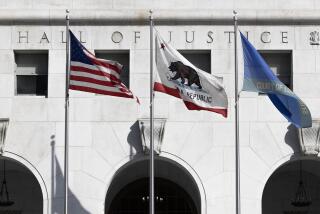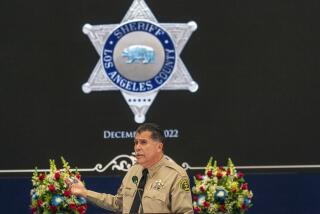Assault Case Involving Cerritos Bridal Party Melee Goes to Jury : Trial: Three men at shower were charged with assault. But a neighbor’s videotape shows sheriff’s deputies clubbing handcuffed people. Defense says it was police brutality.
Defense attorneys in the trial of three men charged with rioting and assaulting Los Angeles County sheriff’s deputies during a Cerritos bridal shower have based their case on countercharges of police brutality.
The heart of their defense has been a videotape made by a neighbor that shows deputies clubbing handcuffed people made to lie face down on the ground.
Closing arguments in the trial ended Tuesday and the Norwalk Superior Court jury hearing the case is expected to begin deliberations today.
From the start of the trial six weeks ago, defense attorneys have tried to persuade the jury that it was the deputies who assaulted citizens during the shower on Feb. 11, 1989, then conspired to falsify evidence against them.
Defense attorney Hugh Manes told the jury Tuesday that the deputies broke up a “perfectly decent, quiet gathering,” using their billy clubs. Afterward, Manes said, the deputies realized that they had injured people and fell back on a rule they learned at the Police Academy--”When you hurt them, you arrest them.”
During the trial, Deputy Russell Stamer, who has since transferred to a police department in Kansas, acknowledged under cross-examination by the defense that he learned early in his police career that if he harmed someone he should charge the person with a crime as a defense against brutality allegations.
The Cerritos incident occurred at the home of Arthur Dole, whose daughter Melinda was being honored at the prenuptial event. The family is Samoan and the incident drew outcries from Southern California’s Samoan community.
Arthur Dole’s son David, 30, a supervisor at a Mervyn’s store in Cerritos, is a defendant. The others are Sale Paopao, 21, a student at El Camino College in Los Angeles, and John Talamaivao, 27, who worked as a security guard at the time.
Three of Dole’s daughters are to be tried on misdemeanor charges stemming from the party melee in which the Doles say that the deputies ransacked and damaged their home. Another party guest also is awaiting trial. A multimillion-dollar suit against the county has been filed by the Dole family and about 40 guests.
The Cerritos case did not draw the same intense national attention as the Rodney G. King beating in Los Angeles, but the critical element in both cases is the same--a homemade videotape showing officers beating people. In the Cerritos case, the people lying on the ground had been handcuffed by the deputies.
The defense has made extensive use of the tape to prove that their clients were beaten and to back up other allegations. Deputies testified that they stormed the Dole home after guests refused to disperse and that they were pelted with rocks, bricks and bottles.
About a dozen deputies testified that they or their colleagues were injured by objects hurled at them. The defense asked them to look at drawings of the front of the Dole home and locate spots where they picked up rocks or bottles. Then the defense showed the tape to the jury, pointing out that no rocks, bricks or bottles were on the front lawn, in the driveway, or in the air flying toward deputies.
The defense also called a San Fernando Valley pathologist who disputed evidence of blood on rocks that the prosecution said were thrown at deputies. The pathologist, Dr. Griffith Thomas, testified that if the rocks had hit the deputies, the blows would have been too brief to leave blood.
The prosecution has argued that the deputies were called to the home by neighbors who were upset over loud music coming from the celebration. The party-goers, the prosecution has argued, refused to disperse and began throwing rocks and bottles when they were confronted by deputies in riot gear.
However, the defense has called neighbors who testified that the noise was not disturbing and that the deputies used excessive force in trying to break up the party.
More to Read
Sign up for Essential California
The most important California stories and recommendations in your inbox every morning.
You may occasionally receive promotional content from the Los Angeles Times.










